The Swedish fly poses a serious threat to agriculture, destroying cereal and forage crops. This insect adapts to any environmental conditions: thanks to its high adaptive abilities, it has spread across the globe and can even be found in the Arctic. Only a carefully planned system of crop protection measures can help defeat this dangerous pest.
Table of contents
What Is This Pest?
The Swedish fly belongs to the Chloropidae family (order Diptera). It was first described in Sweden by the taxonomist Carl Linnaeus (1756). Today, about 30 species of this insect are known.
Appearance
An adult has an elongated body, 1.5-2.5 mm in size, with a black colouration. The female’s abdomen is thicker and ends in a narrow ovipositor. The scutellum is rounded, and the back is slightly convex and smooth.
The wings are small, transparent, with a metallic sheen. The head features a small proboscis and black antennae.
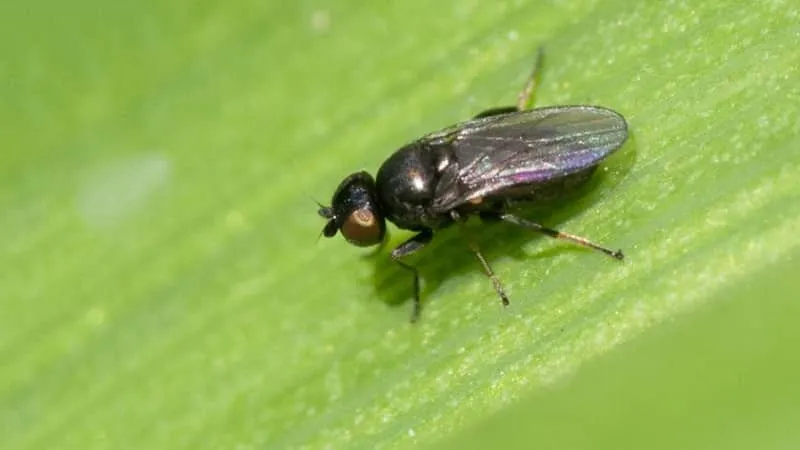
Why It Is Dangerous for Winter Wheat
The Swedish fly primarily damages winter wheat in autumn. Emerging in late September, females lay eggs in the leaf axils of young shoots during the second-leaf stage. Egg-laying then pauses and usually stops after 50% of the third leaf has emerged.
The voracious larvae, which are twice the size of an adult, burrow into the shoots at the base of the stem. They tunnel upwards, reaching the ear primordium, and consume it along with the milky grains.
If the larvae damage the main stem, the plant dies, leading to a significant yield reduction—up to 50%.
Note! Swedish fly larvae damage around 20 cultivated and 46 wild grass species.
Reproduction and Life Cycle
The pests reproduce so quickly that they can produce up to five generations per season under favourable weather conditions. The female carefully selects a suitable location, inspecting stems with her antennae before laying eggs in cereal plants at a specific growth stage. The eggs measure 0.7-0.8 mm.
Larvae develop inside the egg for about eight days before emerging to feed. Using special salivary glands that secrete enzymes to break down plant tissue, they consume the developing wheat grains.
In nature, the larval stage lasts about a month with sufficient food, and up to 40 days in laboratory conditions. Without food, they survive for a maximum of seven days.
The insect overwinters in hibernation as a pupa in the stubble of perennial grasses and winter crop seedlings. It becomes active in spring when temperatures rise above +12°C.
Causes of Infestation
The main reason for its widespread presence is its ability to adapt to various climates. Other factors contributing to its spread on winter wheat include:
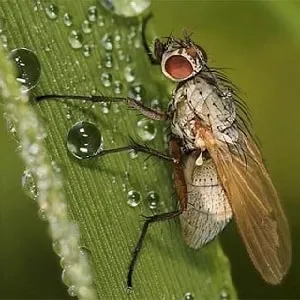 Prolonged warm autumn. Extends the pest’s damaging period (at +10°C, the insect goes dormant).
Prolonged warm autumn. Extends the pest’s damaging period (at +10°C, the insect goes dormant).- Dry conditions. Arid weather promotes rapid larval development.
- Nutrient availability for winter crops. Well-nourished plants grow stronger and faster, shortening the pest’s feeding window.
- Optimal temperatures for larval growth (above +10°C).
- The insect’s ability to migrate over long distances.
Symptoms of Infestation
The larvae primarily affect stem development. The central leaf wilts and yellows, sometimes disappearing entirely—either falling off or failing to emerge from the leaf axil. Visible damage appears about two weeks after larval infestation.
The plant redirects nutrients to damaged areas, causing leaves to darken and stems to thicken. Experts use these signs to identify Swedish fly infestations in wheat fields.
Control Methods
Damage from this pest can be significantly reduced with the right control strategies.
Agronomic Measures
The most effective methods include:
- Crop rotation. Ideal predecessors: legumes (clover, alfalfa, peas, soybeans, vetch-oat mix), maize, and annual grasses (excluding sorghum and Sudan grass). Avoid planting wheat in the same field for more than two years.
- Selecting resistant seed varieties with strong cell structures that protect against larval damage.
- Planting late-maturing varieties (e.g., Maris Huntsman, Hereward, Rialto) at optimal times so seedlings emerge near frost, when flies are dormant.
- Increasing seeding rates to ensure sufficient surviving plants for a stable yield.
- Deep ploughing of soil.
- Applying nitrogen fertilisers to winter crops to enhance plant resilience.
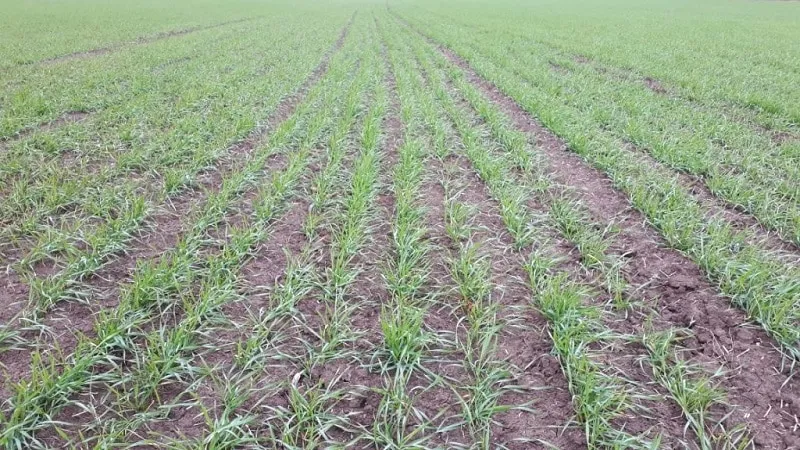
Chemical Control
Chemical treatments are applied during egg-laying and mass flights. Aerial dusting with 12% HCH is common in some regions when wheat is in the first-leaf stage.
Spraying with chlorinated hydrocarbons and organophosphates reduces pest populations. Insecticides such as Cruiser and Celest Top are also used.
Warning! Post-treatment mortality reaches 93%, increasing yields by 20% or more.
Preventive Measures
To ensure high yields, implement these preventive steps:
- Timely stubble cultivation to destroy pests and larvae.
- Using high-quality, calibrated seeds. They produce strong, uniform seedlings resistant to Swedish fly attacks.
- Seed treatment before sowing with products like Gaucho or Cruiser.
- Planting cereals after legumes or row crops.
Other Wheat Pests in Fields and Storage
Cereal pests are numerous. Below are the most damaging species.
Stink Bug (Eurygaster spp.)
This insect primarily feeds on wheat, damaging both winter and spring crops. Resembling a tiny turtle, its life cycle aligns with cereal growth stages, making it active throughout summer—harming fields and stored grain.
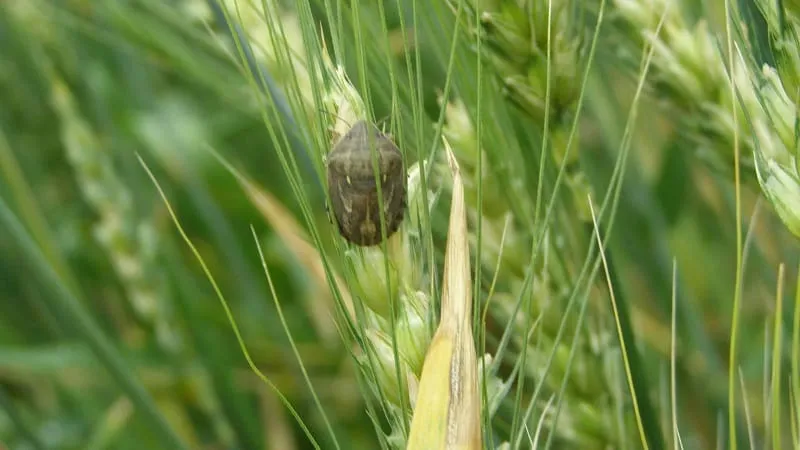
Thrips
Wheat thrips harm winter and spring wheat, as well as some perennial grasses. Both adults and larvae feed on sap from leaf sheaths or young leaves, stunting growth.
Grains become scarred and malformed, reducing quality. The insect is a tiny (1.3-1.5 mm) black-brown fly with underdeveloped wings.
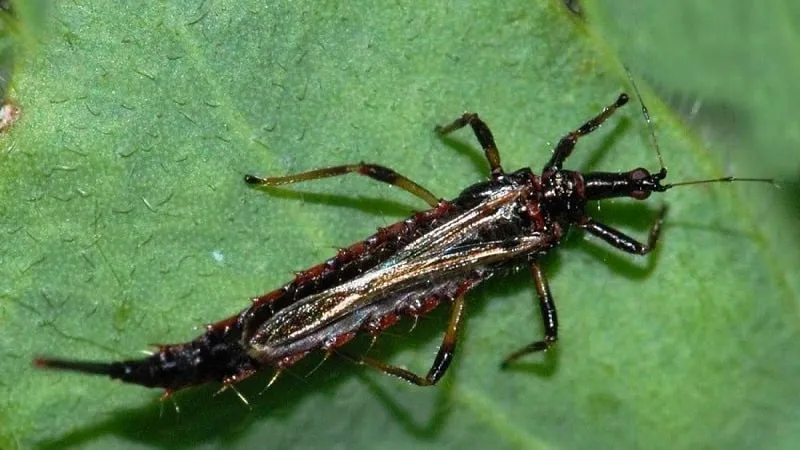
Ground Beetle
The grain ground beetle severely damages winter wheat. Larvae attack seedlings during tillering, shredding leaves and stems. Adults target ears, gnawing husks and developing grains.
The beetle measures 12-17 mm, with a pitch-black, bronze-tinged body. It has a large head, short antennae, and ridged wing covers.
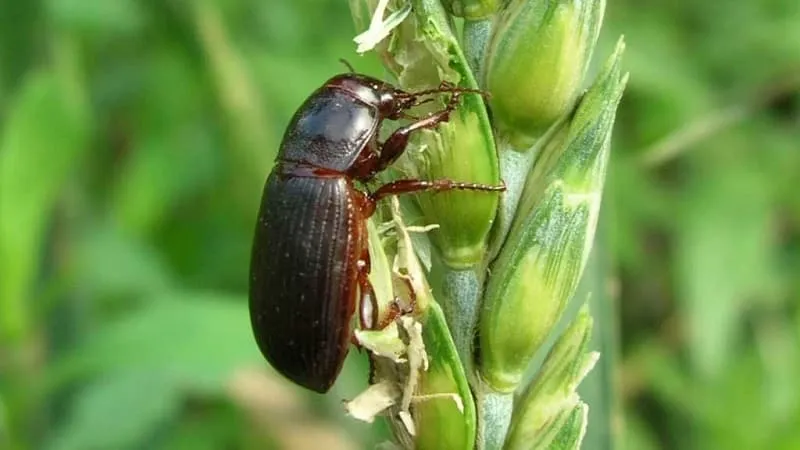
Grain Weevil
This beetle’s elongated snout pierces grain husks. It is a major pest of wheat, barley, maize, and stored pasta, ruining household pantries and grain silos alike.
The 4-mm-long, dark-brown insect cannot fly but spreads via grain shipments.
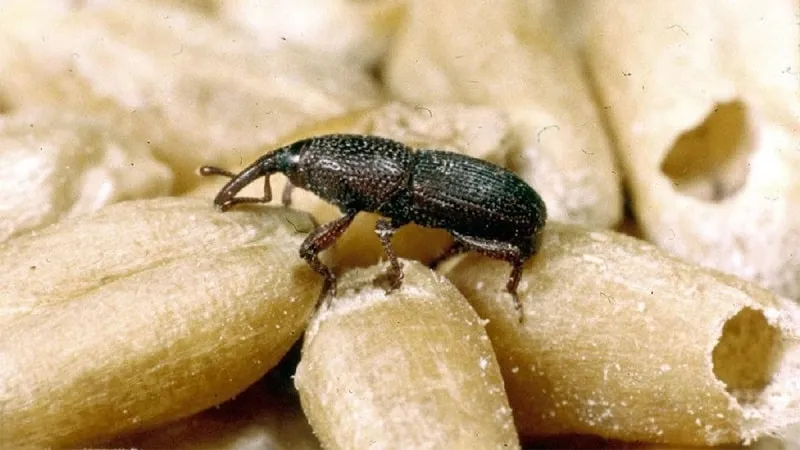
How to Combat Wheat Pests
Control and prevention methods for these pests include:
- Agronomic practices: stubble cultivation, deep ploughing, crop rotation, and resistant varieties.
- Chemical treatments: spraying approved insecticides like Karate, Arrivo, Fastac, or Actellic.
- Preventive measures: treating stored grain with carbendazim, mancozeb, or triticonazole; thorough drying; warehouse cleaning; and disinfection (e.g., formaldehyde fumigation).
Conclusion
The Swedish fly and other wheat pests can devastate crops without timely intervention. Integrated agronomic, chemical, and preventive measures are essential for protecting fields and stored grain.







